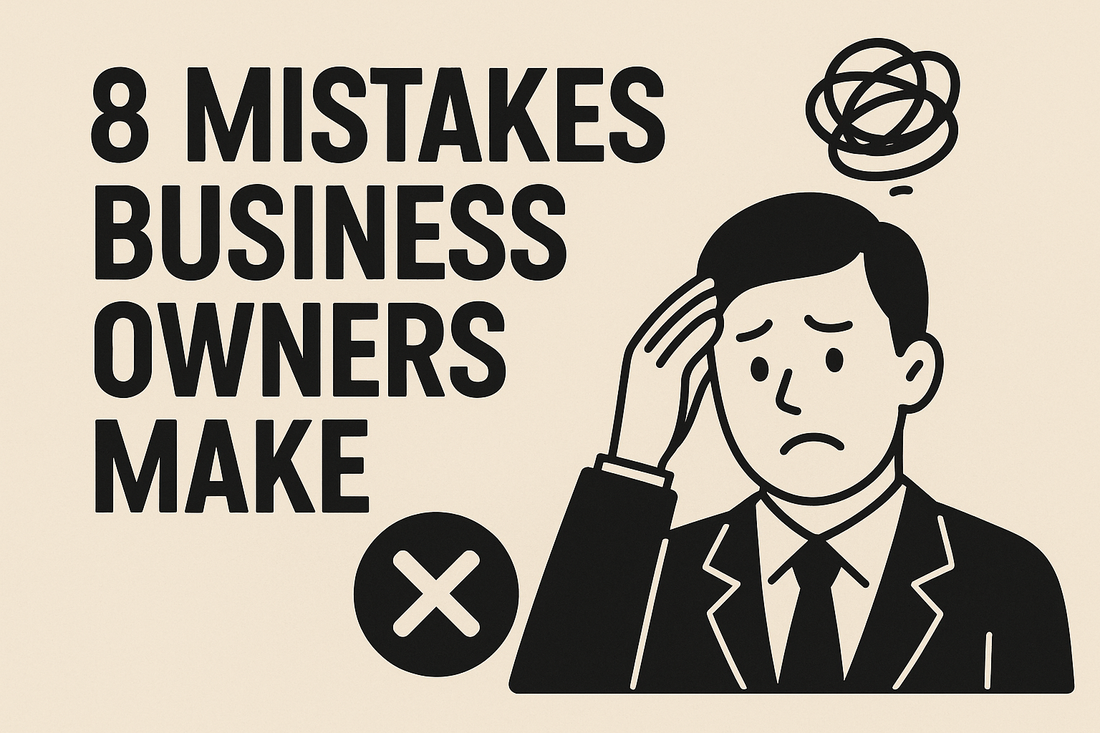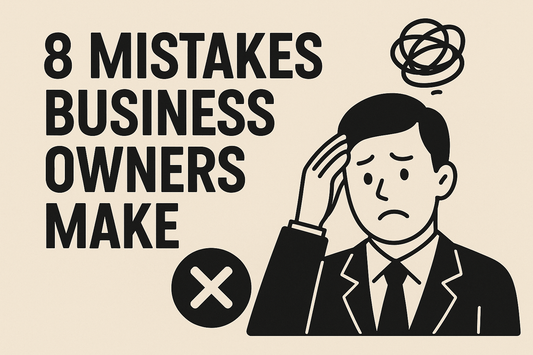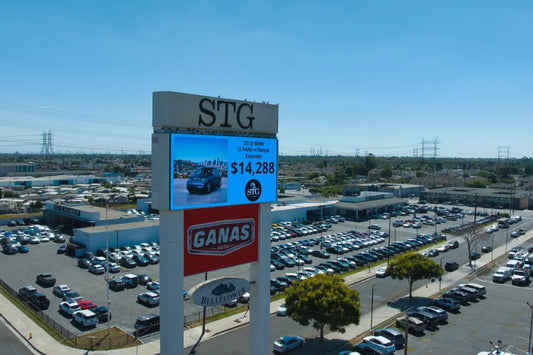
The 8 Biggest Mistakes Brick-and-Mortar Businesses Are Making in 2025 (And How to Fix Them)
The retail landscape has transformed dramatically over the past few years, yet many brick-and-mortar businesses are still operating with outdated strategies. As a team that works with physical businesses daily, we've noticed recurring patterns that are costing retailers customers, revenue, and growth opportunities.
Here are the eight biggest mistakes we're seeing in 2025—and more importantly, how to fix them.
1. Ignoring the "Google Business Profile"
The Mistake: Many businesses still haven't claimed their Google Business Profile, leaving potential customers with outdated information, no photos, or worse—competitors appearing above them in local search results. With nearly half of all Google searches featuring local intent, this oversight is costing businesses visibility.
Why It Matters: When someone searches "coffee shop near me" or "hardware store open now," Google prioritizes businesses with complete, active profiles. According to research, 76% of consumers who search for something nearby visit a business within a day, and 88% of individuals who use a smartphone for a local search visit a related store within a week. Without an optimized profile, you're essentially invisible to nearby customers actively looking to spend money.
The Fix:
- Claim and verify your Google Business Profile immediately
- Add high-quality photos of your storefront, products, and interior
- Update your hours weekly, especially around holidays
- Respond to every review within 24-48 hours
- Post updates at least twice per week about promotions, new products, or events
2. Treating Social Media Like a Billboard
The Mistake: Posting promotional content without engaging with the community. We see businesses that post "20% off this weekend!" and wonder why their engagement is abysmal.
Why It Matters: Social media algorithms in 2025 prioritize content that sparks conversation and engagement. Research consistently shows that posts asking questions or encouraging interaction receive significantly more engagement than purely promotional posts.
The Fix:
- Follow the 80/20 rule: 80% valuable/entertaining content, 20% promotional
- Respond to comments and direct messages within hours, not days
- Share behind-the-scenes content that humanizes your business
- Create location-specific content that resonates with your local community
- Use Instagram Stories and TikTok to show your personality, not just your products
3. Neglecting the First 10 Feet of Your Store
The Mistake: Cluttering your entrance with sale bins, outdated signage, or making it unclear whether you're even open for business.
Why It Matters: Customers make unconscious decisions about whether to enter a store within 3-7 seconds of approaching. A cluttered or uninviting entrance can cost you up to 40% of potential foot traffic—people will literally walk past without even realizing you're a viable option.
The Fix:
- Keep your entrance clear and inviting with a defined "decompression zone"
- Ensure your storefront is well-lit, especially during evening hours
- Update window displays every 2-4 weeks to create "newness"
- Make your signage clearly visible from at least 50 feet away
- Add fresh flowers, plants, or seasonal decorations to create warmth
4. Not Collecting Customer Data
The Mistake: Letting customers walk out without any way to contact them again. Cash register, credit card payment, goodbye. The relationship ends at the door.
Why It Matters: According to Harvard Business Review, acquiring a new customer can cost anywhere from 5 to 25 times more than retaining an existing one. Without customer data, you're constantly spending money to attract new faces instead of nurturing relationships with people who already know and trust you.
The Fix:
- Implement a simple email signup at checkout (offer a 10% discount on next purchase)
- Use a modern POS system that tracks customer purchase history
- Create a loyalty program that actually rewards frequent shoppers
- Send personalized birthday discounts or anniversary emails
- Text message marketing (with permission) has a 98% open rate compared to 20% for email
5. Competing on Price Instead of Experience
The Mistake: Trying to beat Amazon or big-box retailers on price alone. We see small businesses constantly discounting, eroding their margins while wondering why they can't stay profitable.
Why It Matters: You'll never win a price war against companies with billion-dollar supply chains. Research shows that 73% of consumers point to experience as an important factor in their purchasing decisions, and customers are willing to pay more for the experience qualities that matter most to them.
The Fix:
- Train staff to be knowledgeable consultants, not just cashiers
- Create Instagram-worthy moments in your store (photo walls, unique displays)
- Offer services big retailers can't: personal shopping, customization, expert advice
- Build community through events, workshops, or classes
- Focus on convenience: same-day service, local delivery, or curbside pickup
6. Having a Mobile-Hostile Website (Or No Website At All)
The Mistake: Either operating without a website or having one that was built in 2015 and doesn't work on smartphones. We've even seen businesses where you can't find basic information like hours or location without multiple clicks.
Why It Matters: Mobile devices drive roughly 58% of all Google Search traffic, and 78% of local mobile searches result in offline purchases. If your website isn't mobile-friendly, Google actively penalizes you in search rankings. Plus, a slow or broken mobile experience sends customers straight to your competitors.
The Fix:
- Ensure your website loads in under 3 seconds on mobile
- Make phone number and address clickable (tap to call, tap for directions)
- Show your hours prominently on every page
- Include real photos of your products and location, not stock images
- Add an FAQ section addressing common customer questions
- Enable Google Maps integration so customers can navigate directly to you
7. Underestimating the Power of Customer Reviews
The Mistake: Ignoring online reviews or, worse, getting defensive and arguing with negative reviewers. Some businesses we work with don't even know they have reviews on multiple platforms.
Why It Matters: Research shows that 75% of consumers say they always or regularly read online reviews when researching local businesses, and the average consumer reads multiple reviews before making a decision. Your star rating and how you respond to criticism directly impacts your bottom line.
The Fix:
- Set up Google Alerts for your business name to catch reviews immediately
- Respond professionally to negative reviews within 24 hours (apologize, offer solutions, take it offline)
- Thank customers for positive reviews personally
- Make it easy for happy customers to leave reviews (send follow-up texts with direct links)
- Display positive reviews in-store and on your website
- Never offer incentives for positive reviews (it violates most platform policies)
8. Ignoring Tax Advantages and Business Deductions
The Mistake: Either failing to take legitimate tax deductions that could save thousands of dollars annually, or conversely, writing off too much and artificially deflating your income to levels that hurt your ability to secure financing.
Why It Matters: Many brick-and-mortar businesses leave money on the table every year by not maximizing legitimate business deductions. Equipment purchases, signage, renovations, marketing expenses, and operational costs can often be written off—sometimes immediately through provisions like Section 179. However, we also see the opposite problem: business owners who aggressively write off every possible expense, showing minimal profit on paper, only to discover they can't qualify for a business loan, commercial lease, or even a mortgage when they need it.
The Tax Opportunity You're Missing: From storefront improvements to equipment upgrades, many capital investments qualify for immediate tax deductions. For example, business signage and LED signs often qualify for Section 179 deductions, allowing you to deduct the full cost in the year of purchase rather than depreciating it over years. The same applies to point-of-sale systems, furniture, security systems, and even certain renovations.
The Hidden Cost of Over-Deducting: While minimizing your tax bill feels smart in the moment, showing little-to-no profit year after year creates serious problems. Banks and lenders use your tax returns to evaluate loan applications. If your business shows $30,000 in annual profit on paper, that's what lenders believe you earn—regardless of how much you actually took home through various deductions. This makes it nearly impossible to:
- Qualify for business expansion loans
- Secure favorable commercial lease terms
- Get approved for a mortgage (lenders look at 2-3 years of tax returns)
- Attract investors or partners who want to see profitability
- Sell your business at fair market value
The Fix:
- Work with a business-savvy CPA or tax professional who understands retail operations and can help you strike the right balance between tax efficiency and maintaining healthy-looking financials
- Plan major purchases strategically around your tax situation and future financing needs—don't just buy equipment in December because "it's a write-off"
- Keep immaculate records of all business expenses, even if you don't deduct them immediately, so you have documentation if audited
- Take advantage of accelerated depreciation for qualifying assets like signage, equipment, and renovations through Section 179 or bonus depreciation
- Think 2-3 years ahead if you'll need financing—start showing stronger profits on paper well before you apply for loans
- Separate personal and business expenses religiously—commingling funds is a red flag for both the IRS and lenders
- Document everything: Keep receipts, invoices, and clear business justifications for all deductions
The smartest approach? Maximize legitimate deductions to reduce your tax burden, but don't sacrifice your business's financial credibility for short-term tax savings. Your future self—the one applying for a loan to expand or buy property—will thank you.
The Common Thread: Adapt or Get Left Behind
The businesses thriving in 2025 aren't necessarily the ones with the biggest budgets or the most locations. They're the ones that understand customer behavior has fundamentally changed. Today's shoppers research online before visiting, expect personalized experiences, and value convenience and authenticity over low prices alone.
The good news? Most of these fixes don't require massive capital investment. They require attention, consistency, and a willingness to see your business through your customers' eyes.
Start with one mistake from this list. Fix it completely over the next 30 days. Then move to the next one. Small, consistent improvements compound into significant competitive advantages.
The brick-and-mortar businesses that will succeed in 2025 and beyond aren't fighting against e-commerce—they're using digital tools to enhance what physical retail does best: creating human connections, memorable experiences, and trusted community relationships.
Frequently Asked Questions
Most of these fixes are free or low-cost. Claiming your Google Business Profile, improving social media engagement, and responding to reviews cost nothing but time. A mobile-friendly website redesign typically ranges from $2,000-$10,000, but modern platforms like Shopify or Squarespace offer affordable DIY options starting at $20-$40 per month.
Start with your Google Business Profile. It's free, takes less than an hour to set up properly, and immediately impacts how local customers find you. Once that's optimized, focus on collecting customer data so you can build lasting relationships with people already buying from you.
Results vary by fix. Google Business Profile optimization can show increased visibility within 1-2 weeks. Customer data collection builds value over months. Store entrance improvements can impact foot traffic immediately. Plan for 90 days of consistent effort to see measurable improvements across all areas.
Yes, but not on price alone. Physical stores have advantages online retailers can't match: immediate gratification, personal service, hands-on experience, and community connection. Focus on these strengths while using digital tools to make discovering and engaging with your business easier.
Quality beats quantity. For most brick-and-mortar businesses, 3-5 posts per week on your primary platform is sufficient, as long as you're actively responding to comments and messages daily. Consistency matters more than frequency—it's better to post 3 times weekly reliably than 7 times one week and zero the next.
No. While maximizing legitimate deductions is smart, showing minimal profit on paper can prevent you from qualifying for business loans, commercial leases, or mortgages. Work with a CPA to balance tax efficiency with maintaining healthy-looking financials, especially if you'll need financing in the next 2-3 years.
Common deductions include rent, utilities, employee wages, marketing costs, point-of-sale systems, signage, store fixtures, inventory, insurance, and professional services. Many capital purchases like equipment and signage qualify for Section 179 deductions, allowing you to write off the full cost in the year of purchase. Consult with a tax professional to ensure you're maximizing all eligible deductions.





